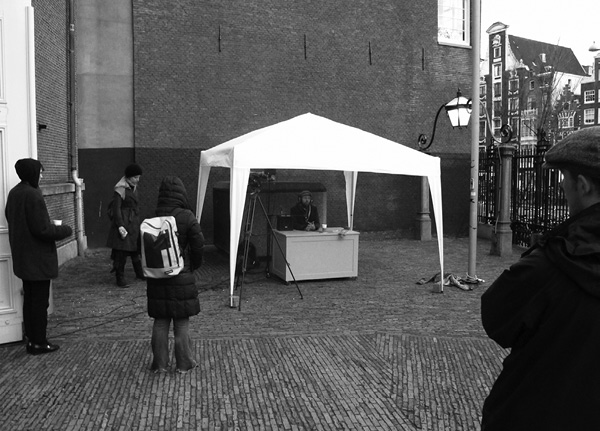
SOLD OUT
first performed on April 25, 2012
Oude Lutherske Kerk (Old Lutheran Church), Amsterdam, Netherlands
performed once in 2012
STEVEN CHODORIWSKY
Antonia Alampi, Katia Krupennikova, Qinyi Lim, Sanne Oorthuizen, Alec Steadman
Englehart, Canada
SOLD OUT
STEVEN CHODORIWSKY
Any public lecture by a famous figure is a highly anticipated event, and can be only attended by a limited number of spectators. Tickets sell out quickly, and in some compensatory cases—when the assigned space cannot accommodate the full audience—a second space is arranged, where overflow attendees may experience the lecture via an audio-video feed. In the case of one such lecture, entitled “Facing Forward: Future Cities” at the Old Lutheran Church, I set up, with the help of a curator, a small public-address system on the doorstep of said venue, with the intention to provide a re-presentation for those unable to enter the lecture, as well as for any bystanders.
Little fanfare was made, and little attention was paid. The lecture’s technical staff, believing the proxy-presentation was affiliated and therefore permitted, ran an audio cable directly from the stage microphone, through the lobby, out the front entrance, and into my headphones. Power sources for the microphone and amplifier were also kindly provided on similar pretense. Under threat of inclement weather, a tent protected the equipment, and gave the proceedings a more official appearance. Refreshments were served.
For the next 150 minutes, I, acting as the proxy-presenter, was charged with the task, to the best of my abilities, of listening to and reciting back the lecture, suitably amplified, outward to the church forecourt, its onlookers, and to the bustling intersection beyond. It was assumed—and indeed turned out—to be a task better left to qualified professionals, and was doomed to approximation at best. Despite my near-unbroken concentration on performing the task of simultaneous recitation, gaps, lapses and non-sequiturs surfaced. These created two disservices: first, to audience members expecting a smooth transmission of basic information, and second, to the portentous, properly theorized content of the live-but-elsewhere, famous lecturing figure.
Why project a figure on a screen, when a poor message- and media-substitute could provide the speech live? And what exactly, or who, has sold out? This small act’s concept owes much to a long history of the one-liner, the unsolicited gag, and the call to critique certain merits of decorum via deadpan mimicry.
But a funny, more serious thing happened. The speech was about “the city,” or more specifically, the pronouncement of a “need for new types of artistic engagement with the future city” (or some such rhetoric). Thanks to the subject (art), the near-verbatim text (now as art) threatened to become its very instantiation. The circuit of thought, speech and act was wound into a kind of recursive absurdity. Content spurred action, unbeknownst to itself.